Home › Forums › Bows and Equipment › Shoulder Shots 2
-
AuthorPosts
-
-
The following are some postings that I had placed on a thread on another site. That thread got closed, but I think there was some very, very pertinent and useful discussion going on. Hopefully it can be continued here. Just keep it all clean and respectful.
Now, I’m not moving or copying over any posting made by another – although I’ve often seen my postings copied to other sites, and often with editing to take the posting totally out of context. Even though stuff posted on the web is in the public domain it just isn’t right to reuse it elsewhere without their permission. I’ve also sanitized from my postings the names of all others. So, you will have to use your imagination to fill in all that’s missing but, even if you can’t there are a lot of things contained herein that are worthy of some powerful pondering.
Here we go!
*****************************************************
Just for the record, I will gladly take a bet on those numbers of total shots. It’s pretty likely that I can let them count their small game too! Over just the last quarter century the number of test shots now numbers in the multiple thousands … not including the 627 bow-killed big game animals and the uncounted total of smaller game taken during that same period! Now, I don’t have an actual record of the kills for the quarter century before I started keeping records, but that’s a few hundred more bow-kills to add in too.
Oh, and none of the Indians killed buffalo; they killed bison – a totally different, thin skinned, open-ribbed animal!
Ed
***********
Here’s the link to the 2007, Part 8 Update that list the penetration factors and the degree of importance/effect/influence each has.
(Deleted, look in the “library” – Ed)
There will be a more definitive ‘heavy bone penetration’ update coming with the 2008 testing Updates, but it’s still several months away from publication (it’s around Part 7 or 8).
Hope the info helps,
Ed**********
I did have some good runs!
The first four years I lived in Africa I averaged 300 days/year of hunting … until I took up doing a bit of guiding … and I’ve been retired, and more or less a full time ‘bush bum’ for all of the last 16 years. No money, but lots of time to hunt … and I’ve tended to frequent places without seasons or bag limits.
Life can be SOOOOO GOOD!
Ed**********
Most of the big game kills on my list during the last quarter century were taken with an EFOC arrow setup. Now, at the time I didn’t KNOW that it was an EFOC setup, or even what EFOC did. I didn’t understand what high MA single-bevel broadheads did either, but I was using them. Why? Because it was the arrow setup that had, hands down, worked the very best; proving to be the most lethal of all setups tested in the original Natal Study.
That arrow setup was an original Forgewood with the 190 grain Grizzly. I still have a few. They measure just over 19% FOC. From that setup I’ve gradually moved to higher and higher FOC setups.
During this last quarter century I’ve hit and failed to recover only 4 big game animals. One was a mule deer that was picked up by other hunters before I reached it. A kill, but one “I” failed to recover. Then there was a Minnesota black bear that jumped into a deep water swamp. I waded out as deep as I could go but was unable to follow any further. (It was a remote area; no boat, and no way to get one there.) Then I lost 2 pigs in Australia in 8 seconds. Both ran out onto the mud flats. One I could see down, but not the other. I tried to reach them, but my wrecked knees made it impossible for me to wade through the mud.
I lost more game during the first quarter century I hunted than I like to think about; animals I would not lose today. (Knowledge is the most important thing a bowhunter carries to the woods … and I’ve found some during all these years.) My worst single-year loss was the first year I hunted with a compound, using light arrows and replaceable blade, multiblade broadheads. I hit and failed to recover four deer that year alone.
” Didn’t you shoot bows with just a good flying arrow at a normal weight and make clean kills?” Yes, I did. During those early years I cleanly killed a fair amount of game with such an arrow setup … but I hit and failed to recover a fair share too; far, far more than I have since concentrating on an arrow setup that maximized the arrow’s terminal performance.
Ed
***********
For folks like ______, who make only perfect hits, the arrow setup they choose to use will never matter much. I just do not know how anyone manages to never make a bad hit.
The last truly bad hit I made was about 3 years ago. It was on a pig, standing dead still, broadside, a mere 18 yards away. It was facing to my right (the pig’s right side facing me), with its head turned to its left (away from me). I aimed on the shoulder, right straight above the ball joint. As I took the shot, and as near as I could discern perfectly coincidental with my release, another pig, off to my left and out of sight, snorted. The pig I was shooting at wheeled immediately, and the arrow hit squarely, broadside in the LEFT gut.
It was a pass through shot with a single-blade broadhead. Within 10 yards I found blood but, as is my custom with any pure gut hit, I backed out and waited 12 hours before following the spoor. The pig was recovered approximately 160 yards from where it was hit. Being not pressed immediately after the hit the pig had bedded down and the wound from the super-sharp broadhead left a wound that had continued to bleed freely. Altogether, it was an easy recovery on a very poor hit.
However, the point is I just don’t see how anyone who shoots very much game can never, ever have a bad hit. Stuff DOES happen, regardless of how hard one tries. No one could ask for a more perfect shot setup than I had on that pig. Not alerted, looking away, standing still and perfectly broadside in the bald open.
Now, I’ve had FAR more of what most would call a ‘bad hit’ occur on the bones of the shoulder than I have had ‘back of the diaphragm’. That’s very likely because I aim on the shoulder, not back of the shoulder. That greatly reduces the number of ‘too far back’ hits. Most animals that move to the sound of a shot duck and then either move forward or turn to their right or left.
Let’s analyze that. If an animal ducks down the shot goes high. Spine? If aiming on the shoulder it could mean scapular flat, or scapular flat plus spine. It they turn either left or right or, even worse, both move forward and turn to either side, AND you are aiming ‘back of the shoulder’ you have just set up for a perfect one lung hit – the hit that is most likely to NOT be a fatal hit. If you are aiming ON the shoulder of an animal the animal has to make a far greater degree of left or right turn (or move forward, with a left or right turn) before one lung passes through and out of the ‘kill zone’ of your aiming point. If you are aiming ON the shoulder and the animal jumps straight forward it again has to move a far greater distance before the lungs pass through and out of the ‘kill zone’ of you aiming point.
In the last quarter century I’ve not had an arrow stopped by any shoulder bone, or combination of shoulder bones, on a single hunted animal. That takes in a fair number of big game animals, with many being “sizable” critters. Some believe that there is no such thing as a ‘bone breaking arrow’. In the 2007-2008 testing, EVERY penetration enhanced, structurally secure EFOC/Ultra-EFOC arrow having a mass weight above the Heavy Bone Threshold passed through the heavy bones of the Asian buffalo. That includes EVERY rib, scapula and spine hit. This represents 169 CONSECUTIVE HEAVY BONE HITS with such an arrow setup. Only half of those shots (52%) were with the heavier 82# Straight end longbow, and nearly 20% of the shots were with the 40# recurve! The balance of those 169 shots were with 54#, 64# and 70# longbows, with less than 3% of the shots being with a 60# compound. No arrow setup is a bone breaker? What do you think is the “likely outcome” with any of these arrow/bow combinations when hitting the heavy bones of a deer sized animal? Failing to smash through even the heaviest bones in a deer’s body is about as close to a ‘nil probability’ as one can get. When using such an arrow setup there is no reason to fear the bones of the shoulder, should you hit one, and therefore no reason not to aim directly on the shoulder, reducing the likelihood of either a single lung hit or a hit too far back. (There will be a more complete reporting on the Study’s bone-breaking shots, and this entire topic, in one of the later 2008 Updates.)
I’ll never have any problems with the setup any bowhunter is using if he rarely (or never) hits and fails to recover game. If he is hitting and failing to recover game on anything more than a ‘rarely’ basis, then his arrow setup can be improved.
After what is now over a half century of big game bowhunting I am totally convinced that a solid body hit ANYWHERE with a TRULY SHARP broadhead results in a dead and recoverably animal IF the arrow penetrates sufficiently AND the hunter has the skills and knowledge to proper follow-up after the hit. The one acceptation is the one-ling hit. If the BH is TRULY sharp there’s a higher probability of a one lung hit proving fatal, but the follow-up of a one-lung hit animal (even with that TRULY SHARP broadhead) should be just like that for a pure gut hit. Press a one-lung hit animal and jump it up and the odds of recovery go way, way down.
Just one point about one lung hits. I’ve been through several tactical firearms courses, including FLETC (the Federal Law Enforcement Training Center, in Glenco, Georgia). Do you know why law enforcement officers are taught to engage the ‘bad guys’ from a ‘square on’ shooting position, instead of the ‘facing to the side’ position, as was taught by the military for years? Think about it. Facing ‘square-on’ you give the bad guy(s) a lot bigger target to hit than you do when facing sideways, so why do it? It’s because, if you have your side facing the bad guy and he scores a thorax hit you have almost guaranteed a double-ling hit. Facing square-on, though presenting a larger target, you have greatly reduced the odds of a double lung hit. The survival rate from a one lung hit is very high. Survival rate from a double-lung hit it is very low, even with the best and most immediate of medical care!
Ed
**********
_____, saying something is “close to a nil probability” is not precisely the same as a “guarantee”. To be more precise, there is a very, very, very high probability that the likely outcome when using such and arrow setup against the heavy bones of a deer sized animal will be complete penetration of the bone.
On the other hand ______ is precisely correct in the statement he made. Nowhere in the Study Updates (to date) will you see the word “guarantee”, nor will you find one implied (relative to the topic at hand). I did guarantee one thing in the published Updates: any setup that is fully adequate for buffalo will be fully adequate on any smaller animal.
So, you ask, why am I saying that heavy bone penetration is the very, very, very likely outcome with these setups now? Simple, I’ve never had these kinds of results until I began testing these specific types of arrow setups. Ergo, there was no data to support that type of conclusion. The data is now there.
So, _____, are you suggesting that arrows such as described won’t reliable break out the heavy bones of a deer size animal? If so, on what data do you base that conclusion?
Ed
**********
_____, now let’s not go taking things out of context. The FULL quote is: “When using such an arrow setup there is no reason to fear the bones of the shoulder, should you hit one, and therefore no reason not to aim directly on the shoulder, reducing the likelihood of either a single lung hit or a hit too far back.”
The omitted parts of the quote are the most important ones! You make it sound as though I said “aim directly at the shoulder bones”. That may be what you heard, but it’s not what I said.
Where is there a big problem with aiming at the shoulder? Everyone seems quick to say that, if you hit the scapula you’ve miss all the vitals anyway. Then they post a schematic showing that the scapula well forward of the shoulder when the deer is standing in a leg-straight-down position. So, if the vitals are not directly beneath the scapula what is in the shoulder, between skin and the thorax? Nothing other than meat and ribs.
Please consider that all the true antelope species have vital areas so far forward that a shot hitting back of the shoulder is either a hit right on the diaphragm or back of the diaphragm. No one screams about aiming at the shoulder on the African antelopes, and plenty of folks on this site have been there and hunted them, using that type of aiming point. Almost everyone supports aiming right at the shoulder of pigs, and they have bones heavier than deer. So what’s the big bugaboo with aiming at the shoulder of a whitetail or mule deer? Is there a problem passing along information on an aiming spot that will reduce the number of both one-lung hits and hits too far back? Is there a problem with passing along information on arrow setups that have demonstrated the ability VASTLY improve the likelihood of penetrating the shoulder bones IF they happen to be hit?
Ed
-
😯 This should get interesting:wink:
-
Dr. Ashby,
You post a ton of very useful information for us to mull over and use. Thank you.
I’ve been an aluminum shooter for the extent of my nearly 8 year shooting career. However, when I did try to build an EFOC aluminum arrow, I had problems with the sides of my arrows blowing out. Too brittle of a material to build with? What are your thoughts? Are your EFOC arrows carbon, aluminum or wood? Due to my severe inexperience with wood, I’m considering switching to a carbon shaft for the ease of gaining FOC.
Michael
-
I do think that “crowding the shoulder” does a lot to reduce the number of hits that are “too far back” and, so long as you use an arrow that maximized your chances of breaking any shoulder bones you might hit if your shot goes even farther forward there’s no real downside. The key is to use the right arrow. It’s highly likely that the solid body hit most often not recovered (by the majority of hunters) is one in the stomach, followed by a hit way, way too far back, in the intestines. Right arrow setup and even a ‘bad’ shoulder hit results in a far easier recovery than does ANY hit that’s too far back. At least that been my experience with client’s animals – and that was when followed by highly skilled trackers.
Ed
-
Michael, without question, the easiest shaft to use when building EFOC arrows are the carbons. I also had poor results with aluminum. On wood it becomes difficult to get really high FOC. You either have to add A LOT of weight up front or go to a footed shaft having a rear shaft of very, very light wood.
Carbons are the easy way.
Ed
-
Ed,
Thanks. I’ll most likely go the route of carbons then. Not to be lazy, but I don’t really want to spend a bunch of money that I don’t have, and wind up messing up good wood shafts. Perhaps someday when I get to making my own, or have the luxury of extra money to play with (yeah, right), I’ll buy some good wood footed shafts. What about a tapered shaft? Thicker at the front than the back? And what diameters would a person shoot for on a tapered shaft?
Michael
-
Doc. You rock 😀
I’m not scared of no shoulder lol
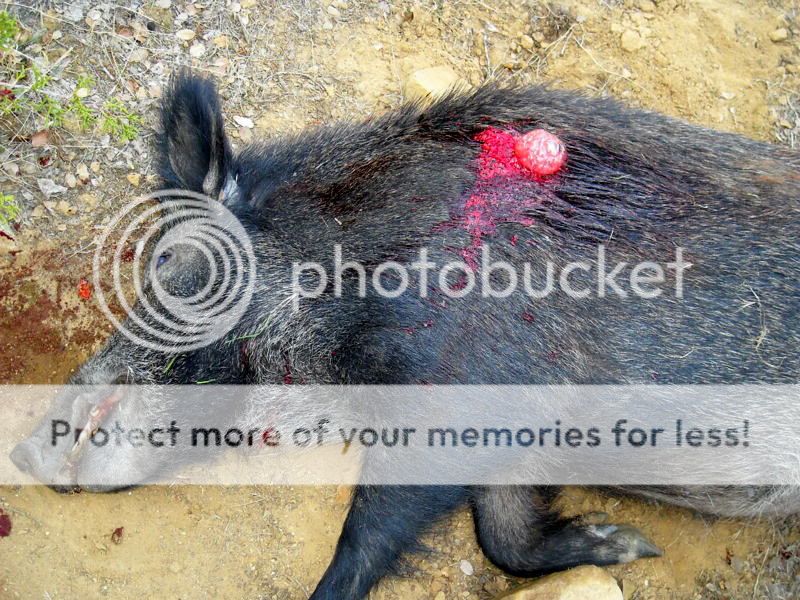
60lb longbow 800 grain arrow 28% efoc 300 grain El Grandy -
Deer was 20 yards quatering away, I was 18 ft up a tree. A large Northern Missouri doe 140lbs live weight deer. This was the entrance side going thru the oppsite side where the scapla and leg bone meet breaking it. Completly going thru, Arrow was a 25%FOC, footed, skinnycarbon with a SilverFlame on top. In the last few years the differance has been huge in penatration since going to the “right” arrow. King what are you talking about, 2 blades dont leave blood trails and arrows dont go throug bones:lol

-
OK, amigos, I’m forced to play moderator here and try to “moderate” this thread in order to keep it on a positive trail. I understand Ed’s frustration with uninformed and openly biased criticism of his careful work and his need to defend himself here. After all, this is the Ashby forum! But let’s please forget about other sites and keep the focus of discussion on the technical info Ed is discussing here — as Michael has done for example. I’ve had to delete a bunch of posts toward that end and trust you understand. For the record I know what you’re speaking of from aggravating personal experience! Re-read my intro comments laying out the ground rules for this forum and you’ll get hints of that. But what is elsewhere should stay elsewhere, and we here don’t need to go there, as we absolutely don’t feel in competition with another site or want any “us vs. them” animosity. (You can of course PM as you wish, as PMs here are in fact private.) So I beg your understanding for deleting posts that are basically innocent and unoffensive. We are determined to avoid that potential minefield and keep this site focused on a positive learning and sharing experience, and by golly I believe our track record, your track record, so far does just that. Thanks for your help and understanding. You guys/gals are the greatest. I’ll conclude by pointing out that one of my test shots on a dead 5×5 bull elk this year was an intentional 45-degrees into the scapula. The “Ashby arrow set-up” blew a big hole in the blade and achieved 17″ penetration! But King’s photos and others here speak louder than words! Steady on …Dave
-
Michael, In the long run you’ll save a lot by just going to carbons for EFOC arrows. You are right about tapering – to a degree. You’ll never get enough weight forward on a self-wood arrow by using just tapering, but it can provide a significant boost to a footed wood shaft that already has a high mass footing and a low mass rear shaft.
Great photos! I knew David wouldn’t be afraid of shoulders – or shoulder bones. He’s been chunking ‘penetration enhanced EFOC arrows’ at game long enough to know. If you shoot enough game you ARE going to encounter heavy bone sooner or later. Once you see what such an arrow setup does to heavy bone you don’t need much more convincing!
Now, nothing is ever infallible (except the predictability of taxes and the Government’s inefficiency and waste thereof), and there will undoubtedly be times when Murphy will intervene to cause a failure of a ‘structurally secure, penetration enhanced EFOC arrow with a mass above the Heavy Bone Threshold’ to penetrate a heavy bone, but all the data shows that it will be a VERY, VERY RARE occurrence – far, far from the norm.
I think – no, there’s enough data now – I KNOW that using better arrow setups AND moving our aiming point onto the shoulder will reduce the wound-loss rate. It will reduce the number of hits too far back. With a ‘penetration enhanced EFOC arrow having a mass above the Heavy Bone Threshold’ and aiming ‘on the shoulder’ the penetration of any heavy bone encountered on a deer-sized animal is going to be a FAR, FAR rarer occurrence than is hitting an animal too far back when using a ‘back of the shoulder’ aiming point. The wound-loss with such arrows and such shots will be less than the wound-loss rate for animals hit too far back and not recovered – even if the too-far-back hit was with a meat cleaver sized broadhead with a zillion blades.
Ed
-
Let me second what Dave just said. The move was only so that discussion of this topic can be carried forward. Forget what is elsewhere. This is an important topic that is directed towards helping reduce the wound-loss rate. That, and nothing more. Let up merely pick up where we were and move forward.
Ed
-
Here’s the deal, the law says you can shoot crap if you want to, because fish and game has no clue of what is an effective arrow broadhead set up, lot’s of folks think surely fish and game would MAKE us shoot tackle that is sufficient to kill at least most of the time.
Then theirs the folk that think because the cave man shot crap for a living, surely his tackle was sufficient, and still there’s the folks that think “I have killed xxxx amount of animals and no ones got a better set up than me.
Then still there are the folk that say this is the way it’s always been done…..
The stubborn & foolish still say the earth is flat regardless of tons of evidence to the contrary.
Colorado division of wildlife is a perfect example of being stuck in the stone age ( except there tag fees are ahead of there time 😡 ) according to there hunting regulations you can hunt Elk & Moose with a 35lb bow and a 200 grain arrow with an expandable broadhead, yep! it’s a 100% legal bow and arrow set up.
I can shoot this set up and there is nothing you can do about it, I also could shoot this set up out to 30-40 yards and there is nothing you can do about it.
Now most of us would say that set up is an abomination; why? it’s legal; most know there is no doubt this set up will fail more than it will succeed, a-ha! 💡 that’s the point.
The ignorant and stubborn just want to shoot what they want to shoot, regardless of the amount of times it might fail, and no amount of information will change there minds ( that’s sad, but it’s true )
I am not a kool-aid drinker, just the opposite, I had to prove what the Doc. was dispensing, however I was getting the same result he was getting before I knew what it was, I just stumbled on the results, as I am always looking for the deadliest set up with the limitations we have chosen.
The Traditional Bowhunting community owes a huge debt to Doctor Ashbey, especially the 40lb shooters as his latest study proves; you also can breach bones should you come in contact with them.
This is one of the recent test volunteers for the Ashbey arrow study.
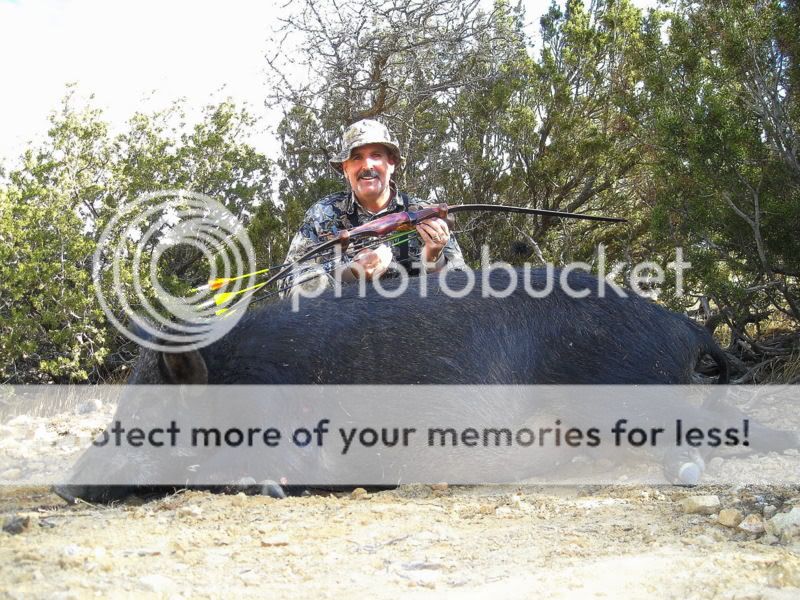
2 blade blind mans blood trail.
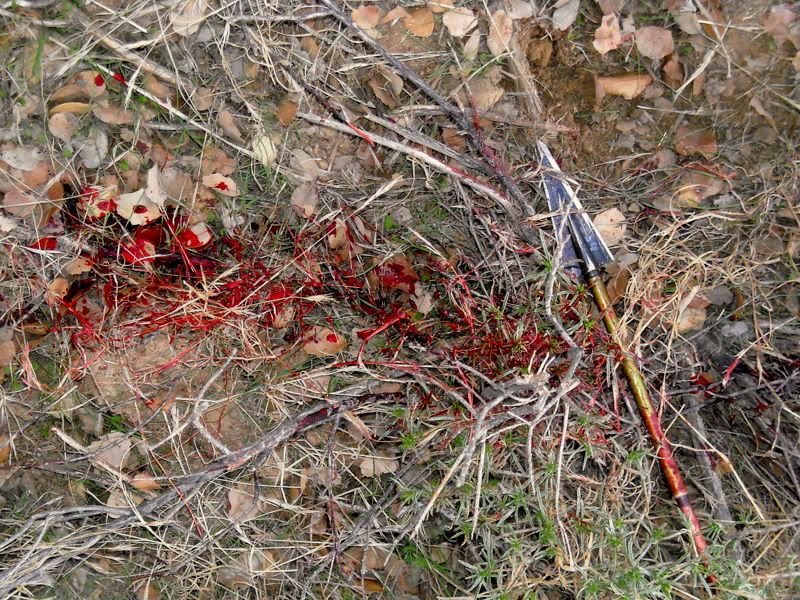
Volunteer #2

It’s about SHARP for a blind mans blood trail, if you struggle with what is sharp, let Ron at KME show you the way.


-
David, as usual, you have made a ‘spot on’ analysis of the situation. The famous Africa hunter/explorer, Fredrick Courtney Selous killed virtually every species of big game animal in all of southern Africa with muzzle loading and/or cartridge-firing black powder rifles, but he lived and hunted will into the somkeless powder era. After finally giving up his ponderous black powder rifles and actually trying one of the ‘newfangled’ smokeless cartridge of much smaller caliber than his huge, black powder shoulder cannons he commented, “Had I had this during whole career I would have killed thrice the number of animals!”.
Some folks are slow to change but, also, someone – some group of individulas – has to be the vanguard. You, David, are right at the forefront of the vanguard. Your great pictures often say more than I can express in 10,000 words!
Thank you.,
Ed -
King David — Man, are you right about the CO draw weight limit of 35 pounds for big game being an embarrassment and abomination! Not to mention a huge insult to the animals we hunt. That is on my list of gripes I present to the wildlife commission at every op, always to be dismissed by the big state bowhunting group, who if nothing else have lobbying the commission and DOW down pat. We can thank CBA for the 35 pound rule. Why, because they wanted their kids and wives to be able to hunt big game even when they’re too weak to pull a decent poundage on a high let-off compound. This group also helped block a very near miss by Doc and me in getting mechanical broadheads outlawed in this state. But we’ll be back! Now, back to Ed’s discussions with us of shoulder shots … don’t want to hijack this excellent thread but just had to get that out. 35 pounds for elk! Lord help the idiots. dave
-
David Petersen wrote: 35 pounds for elk! Lord help the idiots. dave
I killed my first elk in Colorado in 1979 with a cheap 43 lb recurve. It was a mature cow and only went 20 yards after the hit. I don’t know the arrow weight, but it was one of those fiberglass arrows with a 145 gr broadhead – it was heavy. I have to admit, the 35 lb limit scares me less than the 200-300 gr arrow.
-
“I have to admit, the 35 lb limit scares me less than the 200-300 gr arrow.”
Me too! Having seen what can be done with a 40# recurve on an Asian Buffalo, draw weight isn’t the real problem – the problem is the arrow used. The down side of allowing such light draw weight bows is that MOST folks using them are going to use some dainty, fly weight arrow from it – and with about as poor a broadhead choice as they could possibly make. However, there are also a lot of folks using sub-400 grain arrows from heavier bows too and, when bone is hit, those arrows aren’t going to work much better than they would from a 35# bow!
I’ve got several photos of buffalo test shots with low mass arrows and poor broadheads shot from heavy compounds generating just shy of 95 foot-pounds of KE. After they hit and failed to even stick in the rib, the arrows are hanging down like a picador’s lance; held in only by the on-side skin.
Ed
-
Dr. Ed Ashby wrote:
I’ve got several photos of buffalo test shots with low mass arrows and poor broadheads shot from heavy compounds generating just shy of 95 foot-pounds of KE. After they hit and failed to even stick in the rib, the arrows are hanging down like a picador’s lance; held in only by the on-side skin.Back then, I didn’t know much about the “hows and whys” of what it took to kill big game. I just knew that I never doubted that my setup would kill large elk. I knew how easily it sent an arrow through a whitetail and figured the elk didn’t have much chance. It wasn’t until I broke my recurve and decided to give a compound a try, that I started doubting my bow set-up. I got caught up in the speed craze and started shooting lighter arrows out of a 70 lb compound. All of a sudden I had arrows that would not pass through on a medium size whitetail. Yet, when I got a new recurve, the arrows, once again, worked like I expected. They were heavier more by accident than anything. It was what I could get flying well, so it’s what I went with.
It wasn’t until I read your first published study on arrow lethality that my eyes were opened. It hit me almost instantly why my light draw weight recurves were out performing my high KE compounds. Since then, it’s been a steady learning experience – as steady as the frequency of the publishing of your new studies. 😉
-
Doc — such a rare opportunity to “argue” with my teacher! Certainly, your testing has proven that a lighter bow with a heavier, EFoC arrow, penetrates and kills far better than a heavier bow with light, low FoC arrows (broadhead choice notwithstanding). No argument! I’ve proven this to myself by shooting completely through elk with mid-50s longbows and heavy arrows, when I consistently failed to do that with mid-60s recurves and mid-weight (550) arrows. Even so, this is an apples vs oranges discussion. For a state wildlife dept. to declare to the uneducated bowhunting public that 35 pounds is enough for elk, moose and bear, remains a travesty of fact and ethics! Eh, no? dave
-
I personally think it may be time to re-think what is and what is not an “ethical” shot in bowhunting.
Why is it ethical to purposely shoot a deer with an average caliber rifle in the shoulder bones? My answer is because it is usually pretty affective.
When a bowhunter uses an Ultra 650 arrow (650 gr. and Ultra-EFOC) and aims middle and tight to the shoulder, it will ethically and significantly decrease the chance of a guacamole gut shot.
IF the Ultra 650 arrow hits the shoulder bones why would that be considered “unethical” compared to the rifle shot?The arrow is going to do as much or more damage to the deer and have more penetration by a larger projectile than the smaller bullet.
Also, if it IS “unethical” to shoot a deer in the shoulder bones with an adequate arrow like the Ultra 650 then why ISN”T it “unethical” to allow an inadequate arrow to be used at all?
Richie
-
Dave, your analysis is, as usual, very good. The crux of the problem lies with the game department allowing the uneducated public to use a light draw bow while not specifying what type of arrow setup they can and cannot use with it. Between the bow and the arrow, I’d far rather see them regulate minimum arrow standards! If they had minimum arrow weight/arrow setup standards it would deter a lot of folks from using such light draw weight bows, and those who did would at least be using a more adequate arrow.
Richie, I think you are right. I see many touting the ethics of this or that while ignoring that EVERY (non-industry funded) study of bowhunted whitetails done in the last 4 decades has shown a near identical one-to-one wound-loss ratio. Each of those studies has been by either a state game department or a university sponsored program.
Many are quick to promote the industry funded Camp Ripley Study [the one and only study in the last 4 decades that shows a significantly different (lower) wound-loss rate for whitetails – 17%, if I remember correctly; still more than double the average wound-loss rate for firearms]. It’s not comparable. The other studies consider wound-loss to mean hit and not recovered. In the Ripley Study, if the hit deer was not later found dead (actually located by human searchers) it was assumed the deer recovered from the shot and, thusly, was not a “lost” animal.
However, I personally find even the Ripley Study’s skewed wound-loss rate unacceptably high. My experience with both firearms hunted game and bowhunted game indicates that truly sharp broadheads on a good arrow setup are more lethal than bullets; when all type hits are considered; and they yield a lower wound-loss rate. My own wound-loss rate is lower for arrows than rifle hunted game. Under no circumstances should bowhunting’s whitetail wound-loss rate be higher than for firearms.
Why are none of those folks who consider a shoulder shot totally unethical (and have no experience at all with arrow setup capable of rendering them so, by being able to deal with the heavy bones, SHOULD THEY BE HIT) showing any concern about doing something to reduce what IS causing causing unnecessary wounding of game? Or do they, perhaps, think that that bowhuntings current wound-loss rate is acceptable? That it all is merely the result of ‘bad hits’? Something totally unpreventable?
Ed
-
For at least two years now I have asked the other camp that question…Why not look at the facts and prepare for the not-so-perfect shot? They immediately become defensive, which usually means guilt, and twist it around to say nothing.
I have yet to hear any of them say it but I think I know the answer.
The light, fast, flat shooting sexy arrow is just too attractive and they will forever defend it regardless of anything to the contrary.They just will not admit it. That is hilarious.
-
Sapcut wrote: They immediately become defensive, which usually means guilt, and twist it around to say nothing.
I always hear them say to learn to take better shots. Their recommendation are, among others, don’t shoot beyond a certain range, make sure it’s a quartering away shot, be sure the animal is relaxed, not moving and not near a feeder. I say that is fine for those who have great self control and are aware of all these situations, but most novice and occasional hunters don’t consider this stuff like we do. What is best in their hands, when poor hits are the norm, not the exception?
It seems to me that regulations forcing them to use minimum arrow weights that are much higher, would solve a lot of problems. Current regulations don’t even touch on FOC and probably never will since most people won’t have a clue how to determine it. However, it would help if this research could somehow make it into the bowhunter safety classes. I also believe the “need” for speed is so appealing that it would take regulation to make a difference on arrow weight. Now the huge problem – compound shooters rule the bowhunting groups who would lobby for this and they will certainly not support a weight that would truly make a difference. They are overwhelmingly convinced that KE is the important figure and faster and faster arrows are their only goal.
-
Sadly, its more tragic than hilarious :cry:, but it is the reality.
It’s interesting that the 2 earliest bowhunted whitetail wound-loss rate studies I can locate, one from the 1950’s and one the early 1970’s, show a significantly lower wound-loss rate than any of the more recent srudies … even the Ripley study. What has changed so drastically between those early studies and the more recent studies? The setup of the arrows commonly used. During the period of those early studies virtually all (if not ALL) broadheads were of a rigid design. The broadheads most commonly employed were either of a 2 or a 4 blade design. Although a few hunted with 3 blade broadheads (which have far more difficulty on bone hits than either a 2 or 4 blade broadhead) most did not; at least not among the 120 or so bowhunters I hunted with on that first bowhunting-only lease in Texas. (That first bowhunting-only lease was at Wheelock, Texas, and was organized by Bob Lee.) Though there were synthetic shafts they were not of fly-weight design. They were heavy (24SRTX) aluminums, Miocroflites and massively heavy fiberglass shafts from Shakespear and others.
While those early wound-loss rates are way higher than what I’ve achieved with what the Study indicates to be the mosrt effective arrow setup it is also way lower than that of the newer studies. The connection is blatently clear, but ears deafened by media hype do not hear and eyes clouded by too much time staring at the Outdoor Channel do not see.
Ed
-
Well, judging from things I have read some places we should have started at ground zero. Some folks don’t even know what a “shoulder” is. They think ‘shoulder” means the scapula, or the ball joint where the scapula and humerus articulate.
“Shoulder” is a collective anatomical term. It refers to an anatomical region (section) of the body; just as “hip” or “leg” does. The term “shoulder” includes all the tissues – meat, connective tissues and bone – contained in that anatomical region of the body.
The same terms are used in meat processing to refer to the same sections of the carcass. Here are some examples.
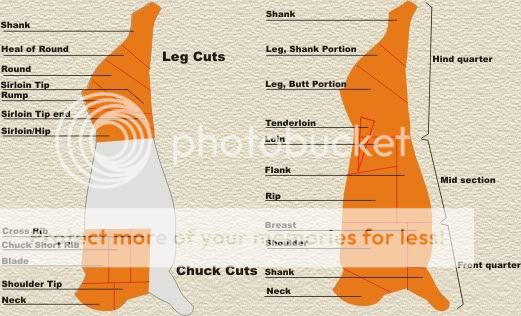

Here’s a processing chart for deer. The same entire region is correctly referred to as the “shoulder”. Note what constitutes the ‘shoulder’ region (section) of the body. It does not change from aminal to animal.
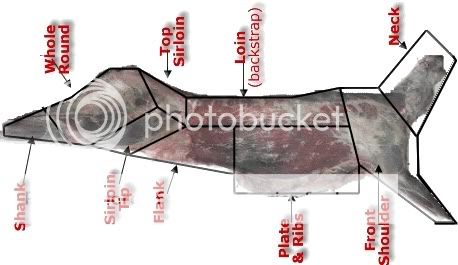
Now, if one is aiming ‘behind the shoulder” the aiming point would be where the white dot appears on the chart below. This is where every bowhunter education class I’ve ever attended (in the States) indicated as proper ‘behind the shoulder” shot placement.
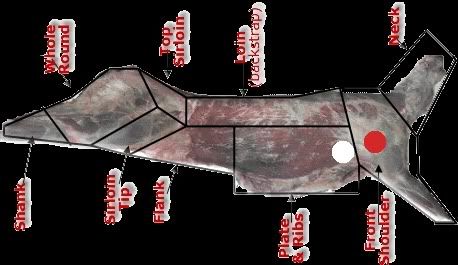
When I speak of “aiming on the shoulder” I’m refering to an aiming point corresponding to the red dot on the chart above.
Here we have a deer standing broadside.

If you aim “back of the shoulder” the following will be your aiming point.
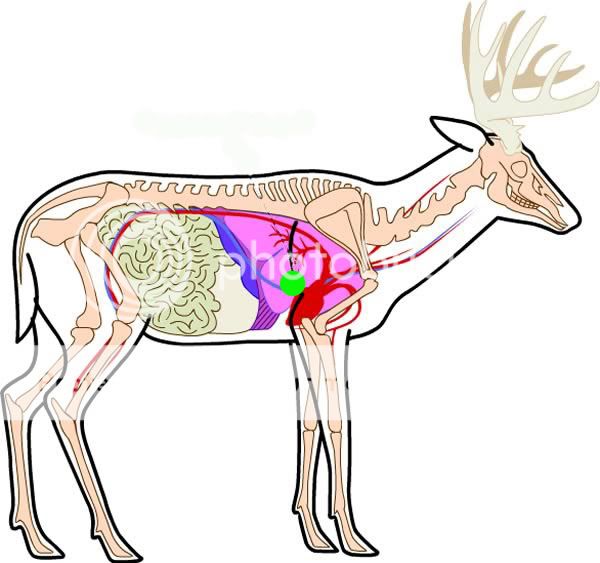
With an aiming point ‘back of the shoulder” this next diagram shows the size of the kill zone, before it first reaches a limiting edge of the thorax/liver area. Now think of the first movements a deer generally makes when it tries to “jumps the string”. It moves down and forward or down while turning either right or left. Think of where the deer’s body will be moving in relation to your kill zone. Use of this ‘back of the shoulder” aiming point is the major cause of hit too far back.
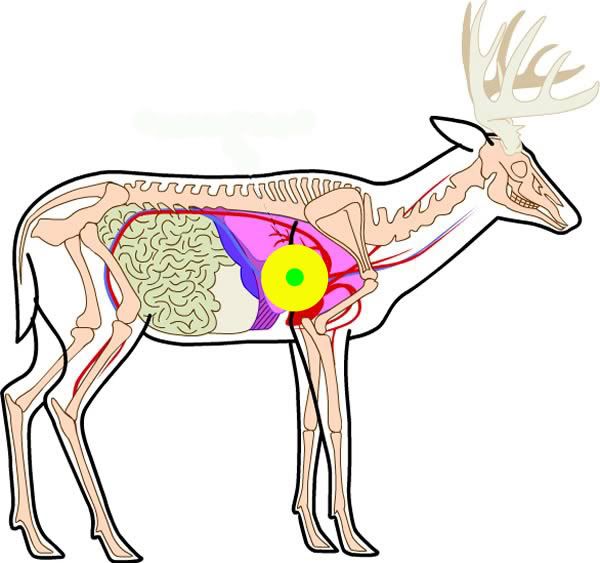
Using a ‘commonly used’ arrow setup, if you aim “on the shoulder” the following diagram shows the size of the kill zone, before it first reaches a limiting edge of the thorax/liver area. It represents a big gain over the ‘behind the shoulder” aim, and allows greater compensation for the animal’s potential movements when the shot is taken.
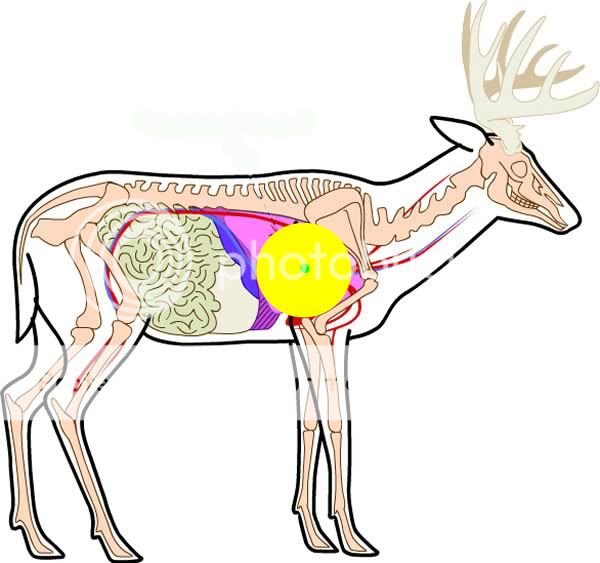
If you are using a penetration enhanced EFOC/Ultra-EFOC arrow setup having a mass weight above the heavy bone threshold the follow diagram shows the size of your effective kill zone with an ‘on the shoulder” aim. Because this type of arrow setup gives an ultra-high probability of penetrating any bone, or even any combination of bones, found in the ‘shoulder’ of a deer sized animal your kill zone is greatly expanded.
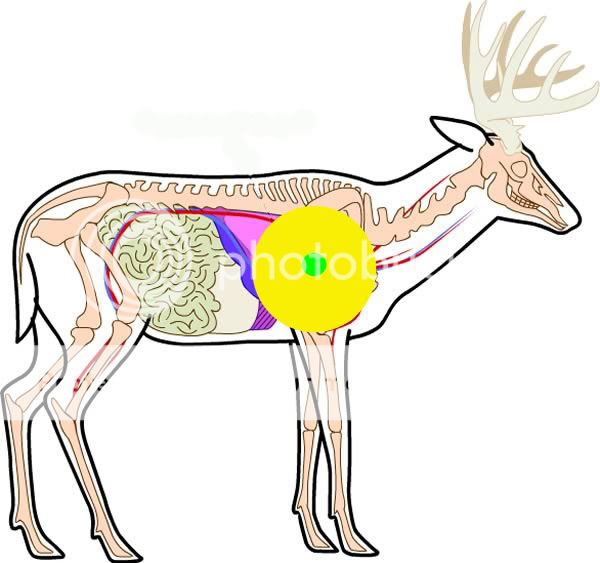
As shown, whether you are using a penetration enhanced arrow or not, the “on the shoulder” aim offers a greater zill zone than when you aim “back of the shoulder”.
Using an arrow setup that gives you the very highest chance of penetrating heavy bone offers other advantages, the above photos are all of deer standing broadside; which is not the most common shooting angle(s). Furthermore, the scapula is not always positioned as shown in the above diagrams. It moves as the position of the leg moves. That’s very likely where the advice to ‘aim behind the shoulder” originated. Here’s a diabram showing how the scapula moves as leg position changes. This particular diagram shows a bear, but the arc of movement of a deer’s scapula is virtually identical.

On some animals, sich as members of the swine and antelope families an aim ‘back of the shoulder” places you arrow extremely near the diaphram, giving an almost non-existant kill zone. Even with an ‘on the shoulder’ aim your kill zone will be small when using most ‘commonly used’ arrow setups, before the first limiting edge of the thorax/liver or heavy bones of the shoulder are reached. The following shows a ‘commonly used’ arrow’s kill zone with a “on the shoulder” aim on a pig.
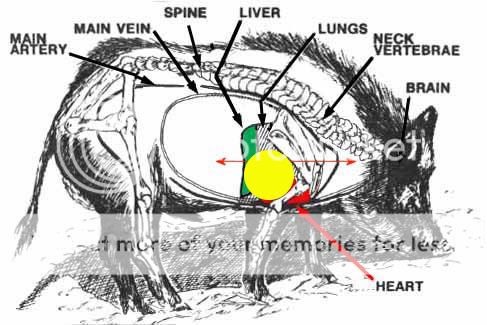
Here’s what the kill zone looks like when you’re using a penetration enhanced EFOC/Ultra-EFOC arrow setup having a mass weight above the heavy bone threshold; a setup that is capable of reliably penetrating the heavy bones of a pig’s shoulder.
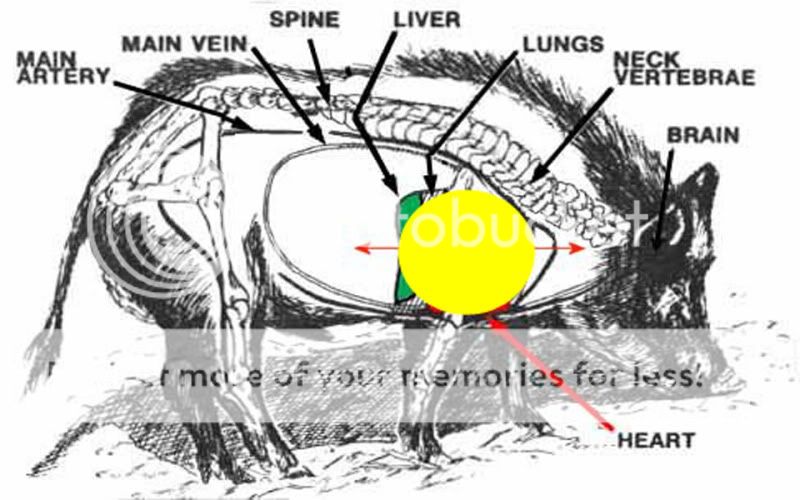
The “on the shoulder” aim’s location is best described as coming straight up from the leg to a point approximately 1/3 of the way up from the lower chest line.
Okay, now we have a common starting place for any discuaaion.
Ed
-
This information is Outstanding. I was on the phone with Dave “King” today and he informed me about this post. I’m setting up a new hunting bow for this season which starts in april with a hog hunt in Texas. I’m off on my First ever Elk hunt in Aug/Sep time frame. I’ll be using a 58# recurve @ 29″ and a 200 El Grande. As for arrow shafting and insert/adaptor weight, I’ll have to tune that. My goal is to be over the 650gr Bone threshold and EFOC of 25-29% Range.
As Dave and I were talking, why set-up a bow/arrow to just get by, rather set-up a bow/arrow to work under any situation. The Information That the Good Doctor has offered us is for US to use or not use. Nothing Bad can come from using this set-up, Only Good…. Thank You Doc and Dave.
Mark
-
Ed, your illustrations really show why in the past I’ve always paid particular attention to where the near-side front leg is positioned – always trying to wait until it is in the forward position. However, as we all know, this leg moves and sometimes to the rear as we shoot, which is why I’ve been so thankful for the knowledge your studies have given me. I am now able to be better prepared for the unexpected.
I can only assume that those trying to avoid the shoulder are purposely trying to hit them in the body-center and disembowel them. However, even if that was my purpose, I don’t know why I’d want to do it with a light weight, low FOC arrow.
-
Mark, I’ll be looking forward to seeing some reports posted (and photos … please) on the results you get on pigs and elk with your setup!
Steve, I too try to watch leg position but when my arrow arrives the animal’s leg is rarely in the same position it was when I shot! That happened just as often when I hunted with compounds as it does with my longbows … and perhaps more often. The longbow is slower, but a lot more silent than any of the compounds I’ve ever shot – and both sound and the animals reaction time are far faster than an arrow from either!
Ed
-
Just for the record, I will gladly take a bet on those numbers of total shots.
It’s pretty likely that I can let them count their small game too! Over just the last quarter century the number of test shots now numbers in the multiple thousands … not including the 627 bow-killed big game animals and the uncounted total of smaller game taken during that same period! Now, I don’t have an actual record of the kills for the quarter century before I started keeping records, but that’s a few hundred more bow-kills to add in too.

The GOOD BOOK says; give honor where honor is do, it aint bragging if it’s facts
Some of the self proclaimed whitetail gurus and wabbit killers, can’t hold a candle to the hunting record or the documentation of what Doctor Ed Ashby has done and his selfless sharing of his findings to the hunting community.
I for one, stand up and applaud you Sir.
Now let’s keep Edu-ma-cating the uninformed; as has been stated ten thousand times if the arrow go’s exactly where I have shot it, I can use some really light tackle and almost any broadhead with in reason will kill, however according to ALL study’s for kill and lost game reports there is around a 50% hit lost ratio.( I don’t care if you don’t believe that it’s that high, until you do a study to disprove it, it is the facts right now, done by game department all over north America )
It is my belief that we as the conservators of the wild animals must do everything to make as clean and as quick a kill as we possibly can, this is our duty and responsibility.
It’s not about “we have killed a million animals this way” and “it has worked for hundreds of years” that’s just flat out stupid…… when there is proof that with just minor adjustments in equipment we can increase our killing effectiveness.
-
With out a doubt the quartering away shot offers the biggest and easiest way into the vitals.
This is more of a realistic view for the majority who hunt from trees.
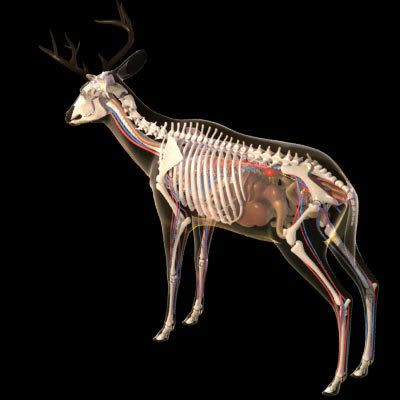
This is more of a level ground view and if the deer takes a step and brings the humerus back it will cover some of the vitals, some times taking a step at the shot and spinning.
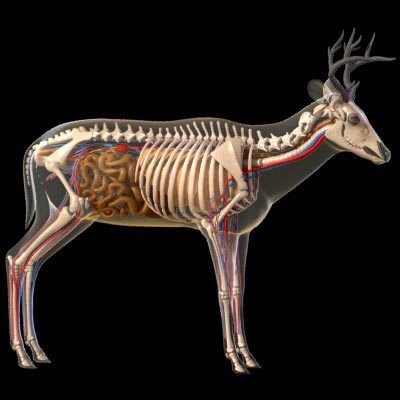
As you can see the bones are starting to cover up the vitals and this shot should be avoided, however some times this position happens after the broadside shot has been released and now your hunting tackle will be put to the test
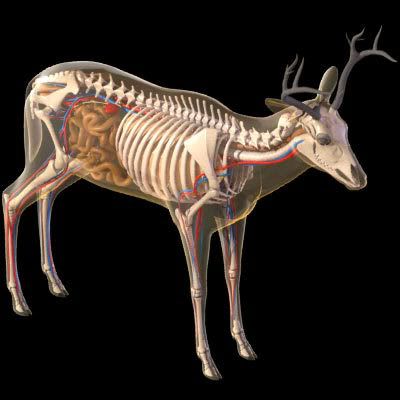
For those who hunt from above, the scapula can come into play vary quickly if the deer reacts at all to the shot
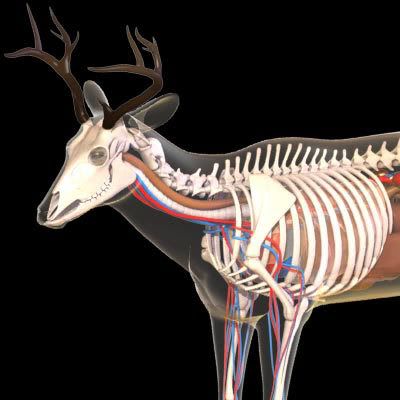
-
The wild boar is tougher and can take a lot more punishment and keep going than a deer.
Shot placement is even more critical with boars, as deer are thin skinned and not built with that heavy of a structure.
This view is from an elevated position
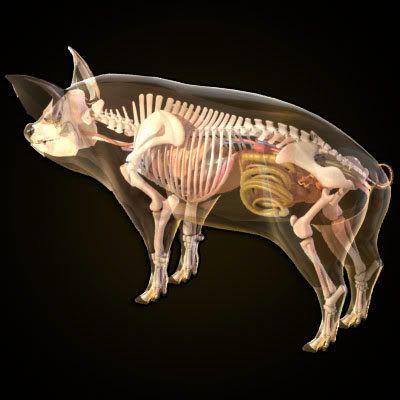
Again quartering away offers the easiest way into the vitals, however can you see how far the spine drops down as it go’s between the shoulder blades bring the kill zone lower than a deer, aiming for the opposite shoulder is the best shot here and will get both lungs.
This view is at eye level and offers the best shot angle with the least amount of resistance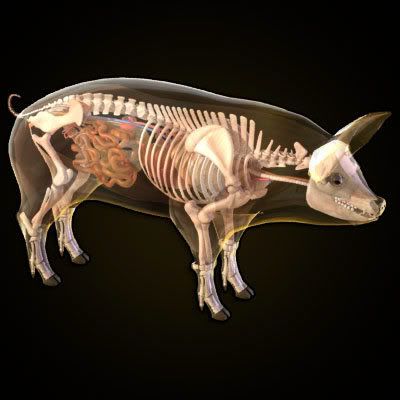
As you can see above a slight quartering at shot still has the vitals open, but shot placement is even more critical as the hog turns toward the shooter, also can you see that the top 1/3 is no vitals and you really must be at least down that far to get into the vitals.If a hog turns at the shot the bone can close the kill zone in a split second.
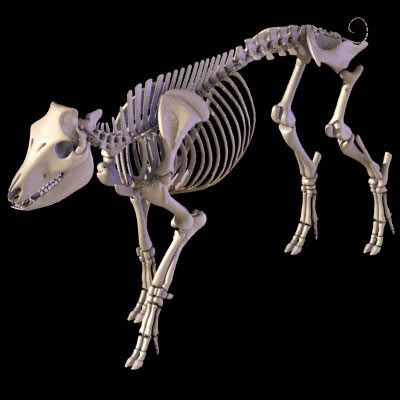
Some times it can be hard to till the exact angle the animal is in as they are constantly moving and not holding still like these pic’s for you to take your time.

This is a no shot -
Shot placement is critical for a good result.

The results I’m looking for lol 😛

-
King, those hog schematics are great. I’ve never been hog hunting (they don’t roam in my neck of the woods), but have considered going on one out of state. Without studying those first, I’d have likely blown it. The lower part of the body has no vitals!
-
David, those are some outstanding diagrams! I’m pilfering those for my library of useful information! There are many useful applications for such great examples.
Next, let me sincerely apologize for ever mentioning the game I’ve shot. Keeping the focus on the Study and off my own hunting has always been a personal goal. My response was prompted because someone had posted that bowhunters W, X, Y and Z had each probably shot arrows into more animals than the total number of arrows I had shot into test animals. It was the downplaying of the Study’s validity; the extent of its database; that made it necessary to set the record straight on the sheer quantity of data the Study’s results are based on; and to make it clear that the Study results are also backed up by actual field results on hunted game.
Now, let’s move on to more important things. Look at David’s last diagram; the quartering from the front shot. The quartering from the front shot was the least effective shot angle in the original Natal Study, and nothing since has changed that.
The problem with the quartering from the front shot is not the quantity of bones presented; it is the angle of incidence between the broadhead/arrow and the bone’s surface. When the shot is quartering from the front most of the bone surfaces present a very oblique angle if incidence to the arrow. That means that it is very easy to exceed the broadhead’s skip angle.
A broadhead’s skip angle is determined by many factors; the broadhead’s length and width, the number and angle of attack of blades, the type of tip on the broadhead, the broadhead’s structural integrity, etcetera. The shorter and wider a blade is the poorer its skip angle. The more blades a broadhead has, the poorer its skip angle. A broadhead that bends redirects the arrow, giving even a poorer skip angle than the BH design would indicate. Even on a well profiled broadhead, the broadhead’s tip design has a marked influence on the skip angle. The very best broadhead designs have a skip angle of approximately 45 degrees. That’s from bone surface. It will be different from different materials. It’s easy to ‘demonstrate’ an arrow sticking at very, very steep incident angles … if you use a piece of plywood.
Skip angle becomes a very important factor when shooting at a downhill angle; regardless of the animal’s ‘quartering angle’ to the shot. I’m absolutely certain that many a ‘pass through’ shot from a tree stand that has resulted in a non-recovered animal wasn’t a pass through at all. It was a shot that skipped off the bone surface at impact, failing to ever enter the body. When such a hit occurs the bowhunter is left with a mental image of the arrow making what appeared to be a solid body hit and a bloody arrow stuck in the ground. The obvious assumption is a pass through hit. Without being able to examine the wound channel the hunter tends to categorize the hit as an unexplainable solid body hit pass through that somehow missed everything vital … or they simply blame that particular broadhead as not being very good.
Now, there will be times when your arrow is going to face a quartering from the front impact angle on an animal. Animals just don’t stand still every time. As with other shots, you want to be using an arrow that gives you the maximum chance that your inadvertent hit at the worst shooting angle will be effective. Fortunately for us shooting the penetration enhanced EFOC/Ultra-EFOC arrows with a weight above the threshold we’re already using that arrow! Our long, narrow, high MA, single blade, single-bevel, Tanto tipped broadhead shows the lowest skip angle of all designs tested. If the Tanto tip does take purchase on the bone’s surface our arrow’s mass above threshold gives a maximum chance of pushing on the bone long enough to exceed the bone’s structural integrity; and the time required for that ‘push’ has been reduced by the tendency of our single-bevel broadhead to split the bone before the arrow has to, literally, force its way through the bone. Our arrow’s extreme amount of FOC will give up greater post-breaching penetration in the even our arrow is successful in breaching the bone.
There is an additional factor worth mentioning. ANY single blade broadhead has an advantage on a quartering from the front impact; whenever they find a space between bones – whether that happens on impact or during a skid off the bone – they show a tendency to ‘right themselves’, aligning the broadhead with the space between the bones. They can’t do this every time. If they hit at a near right angle to an intercostal space the blades then to bite into the bone surface. In this case the arrow must carry sufficient force to drive the broadhead between the ribs, slicing into or chipping away bone, as needed. The rotation induced by our single-bevel broadhead helps here too. It forces the broadhead to rotate and helps chip away the bone as it does so.
If you want to see this single blade broadhead ‘righting effect’ for yourself, set up a series of 3/8″ steel rods, positioned vertically and spaced about 3/8″ to no more than 1/2″ apart. Place them in a securely anchored base, so the shots can’t knock the rods over (mounting the rods in a 4×4 that is secured in a BIG bench vice works well). Back off at a right angle to this steel rod ‘picket fence’ and shoot away with different broadheads. You won’t get any multiblade broadheads through without destroying the broadhead. You will be surprised at how many of the single blade heads ‘right themselves’ to pass between the rods. Should you want to carry this exercise one step further, make a second set of rods that are spaced 2″ apart. This time position the ‘steel rod picket fence’ at a 25 degree angle to your shot and repeat the process. Now turn the ‘fence’ to give a 30 degree impact angle, then on to 35, 40 and 45 degree angles of arrow impact. It’s an enlightening exercise into how drastically broadhead design can alter outcomes.
Now, don’t distort any of the forgoing as saying it’s alright to take quartering from the front shots. It’s not. They are the poorest shooting angle, with the lowest chance of success, and should always be avoided as a deliberate shot. Still it is beneficial to consider what is needed in arrow setup to give us the best odds of making a clean kill, in the event the animal turns towards you and you inadvertently end up making a quartering from the front hit. Fortunately, that ‘best setup’ for the quartering from the front impact is the same fully penetration enhanced EFOC/UltraEFOC arrow that works best on any other heavy bone hit!
Ed
-
Back off at a right angle to this steel rod ‘picket fence’ and shoot away with different broadheads. You won’t get any multiblade broadheads through without destroying the broadhead. You will be surprised at how many of the single blade heads ‘right themselves’ to pass between the rods.
How do you think of this stuff? oh! that’s right, your an old bush bum. 😳 lol
Just incredible the stuff you have tried, I have to agree with the bone being….. well…., what you said about them, they do deflect and redirect any thing that try’s to breach them.
Also the bones move on impact absorbing a lot of the energy, dissipating and redirecting it away, making it even harder to penetrate.
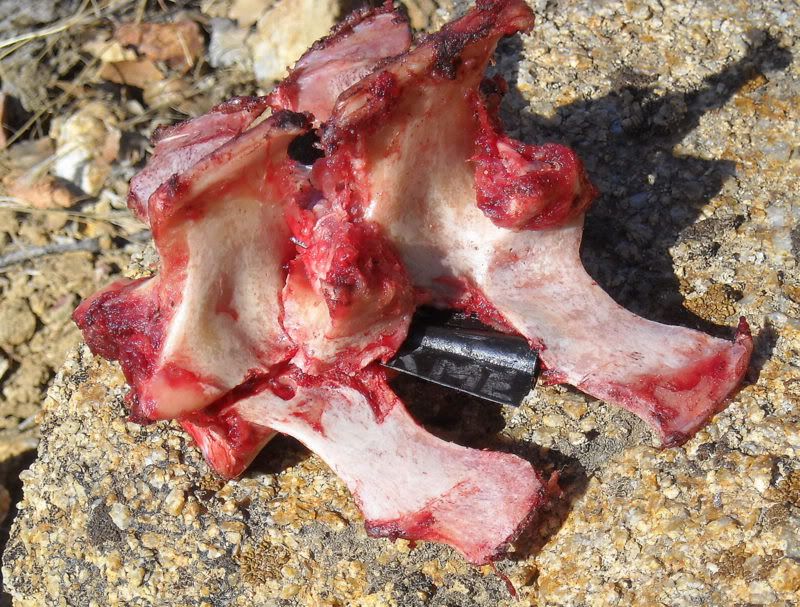
This hog was above me at around 18 yards in it’s bed slightly quartering at me ( I thought it was perfectly broadside, it wasn’t, this can happen more than you think, with the animals body in a different position and angle than it appears ) it was leaning on it’s left side, the arrow went through the near side rib cutting it in two, angling up and slammed into the spine, a vary unique shot angle
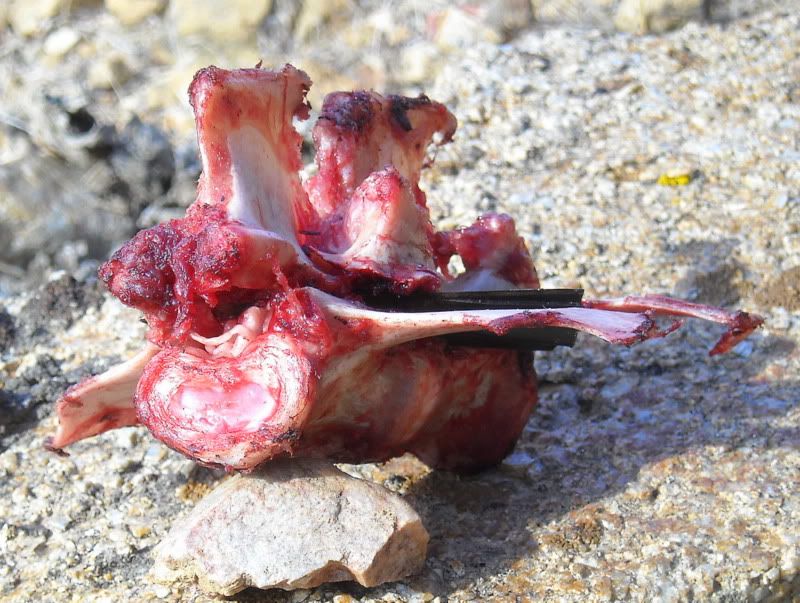
The spine is a geometrical miracle, it has thousands of angles and shock absorbers at each junction, designed to absorb, deflect and redirect any impacts.
As you can see from the pic above it did not just stick into the spine, but started to separate it.
-
As usual some great photos, David! That last one makes an important point. Though the BH has not pierced the spinal cord, the rotating single-bevel broadhead is exerting very substantial pressure on the spinal cord. As I can personally attest, merely placing such pressure on the spinal cord secondary to damage to the bone really has a slowing effect on movement. That’s precisely what happened with my back, and I was instantly and totally incapacitated! The corrective surgery totally removed the back 1/3 of 5 vertebras (L2 through S1), dorsal process and all. Two steel rods and a fistful of HUGE screws held everything together. After nine months of using a bone growth stimulator the bone has regrown to again cover the spinal cord exposed during surgery.
The point being; THAT’S A PRETTY EFFECTIVE HIT for slowing an animal down, if not dropping it on the spot! On a like hit, a double-bevel BH would also have exerted some pressure on the spinal cord, because of the wedge effect of the ferrule, but nowhere near the pressure generated by the rotational torque the single-bevel BH. Little things, but they are what so often make the difference between a successful hit and an unsuccessful hit.
And this concept relates back to the original point, bone skips, and the skip angle of the broadhead you choose to use CAN be a huge factor, and it becomes a factor on far more hits than most folks realize. That’s because very few folks closely examine the course of successful hits to see exactly what occurred on the hit, and even fewer ever get to see what it was that caused an unsuccessful hit to be a failure. More times than most want to admit, those unsuccessful hits boil down to poor performance of the arrow setup that was used, and not merely to a ‘bad shot’.
Ed
-
Dr. Ed Ashby wrote: Our long, narrow, high MA, single blade, single-bevel, Tanto tipped broadhead shows the lowest skip angle of all designs tested.
Ed
Just one quick question…I keep seeing the reference to MA, but I don’t know what it means. Could you clarify this for me? Thanks.
Michael
-
Michael, MA stands for Mechanical Advantage. Any broadhead can be thought of as a series of inclined planes. As you’ll remember from grade shcool science, an inclined plane is a “simple machine” which multiplies the “work” that can be done with a given amount of “available force”.
The higher a broadhead’s MA the more productive “work” (penetration) it can accomplish with whatever ‘useful force’ (that portion of the arrow’s total force that’s not ‘squandered’ on non-productive task, such as shaft vibration and overcoming the drag shaft vibration causes during penetration) the arrow carries. Productive work includes such things as penetration, slicing tissued and breaking through bones – all those task the arrow needs to do to be lethal.
Huge sections of several of the updates are devoted to specific examples of how and why higher broadhead MA has made a difference.
Ed
-
Bert,
Thanks. That’s all I was looking for was what the MA stood for – Mechanical Advantage – Just didn’t know the full lettering. Thanks.
Michael
-
Up next’s is a bunch of bull
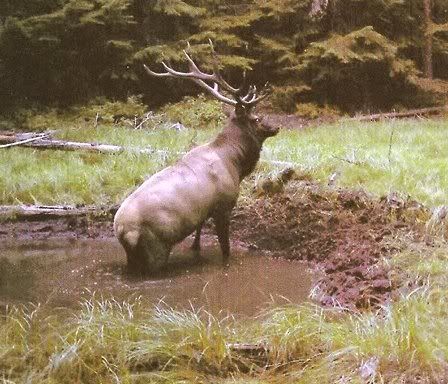
That right there is a bunch of bull……… and would you really shoot at him with a 35lb “D” shaped longbow? 😥 Lord help us.
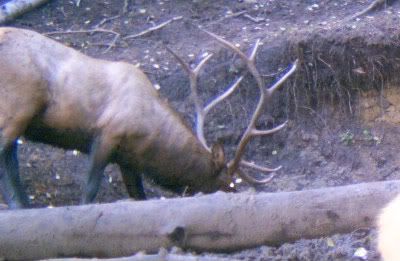
You can see that this bull has his front leg covering his whole heart and a vary large part of his lungs( so you say; wait for him to take a step and move his leg ) well of course I would, however what happens if at the shot he assumes this position with his muscles flexed and there as hard as steel ( flex your bicep, feel how hard it is when you flex it, well I don’t care how hard it is, it’s like pudding compared to a bulls flexed shoulder muscles )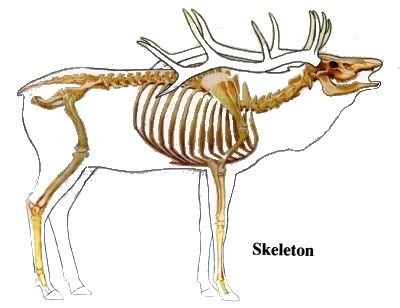
Perfectly broadside and at eye level, what I hope and pray for.
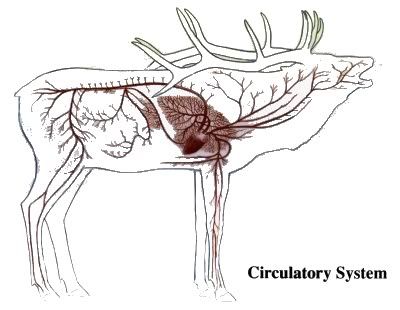
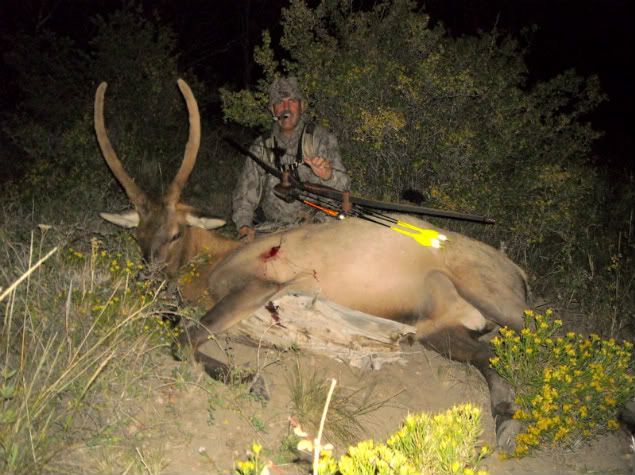
Shoulder shot, slight down hill and slight quartering away around 28 yards, took 2 bounds then all four feet went in the air, rolled farther that he ran -
David, it’s always a quandry, but I’d rather see that 35# D-shaped longbow WITH THE BEST ARROW SETUP POSSIBLE being used than I had a 70# compound with a 380 grain arrow and a poorly designed mechanical broadhead!:( Neither is an appropriate choice, but which is worse::?: not enough bow or not enough arrow? Bow’s don’t kill the animal. Arrows do:!:
Ed
-
As you already know, you’ll get a lot of nay say’ers with a 70lb compound and a 380grain arrow 😈
I understand what your saying, ( I think ) I don’t think anyone will shoot a 650 grain arrow out of 35lb bow 😯 they would truly only have a 5 yard shooting capability.
I am so glad that there is a venue for us all to discus this vary touchy subjects with respect for one another.
-
Kingwouldbe wrote:
I don’t think anyone will shoot a 650 grain arrow out of 35lb bow 😯 they would truly only have a 5 yard shooting capability.I’m shooting in a winter indoor league right now and I’m using a 650 gr arrow (325 gr tip weight) out of a 45 lb recurve. It’s quite adequate inside of 30 yards. I know that dropping 10 lbs draw weight would reduce the distance I’d feel comfortable at, but I would guess that it would be well past 5 yards. With approximately 25% less draw weight, would I lose more than 25% of my effective range? It would seem to me that it would have to be at least 15-20 yards.
Maybe Ed can give us some insight on the effective range of the 700+ gr arrows out of the 40 lb bow. I would guess that would be comparable.
-
David, my point exactly! Regulate the arrow and it begins to pressure folks to use a bit more draw weight … or limit their shooting distance a bit.
As for trajectory with a 700 grain arrow from a 40# draw weight (traditional) bow I can pass along what I found when doing the buffalo testing. The 40# recurve used in the testing was a borrowed Bear Formula Silver target bow. The 2 sets of above threshold EFOC arrows used were each around 725 grains. I shoot all trad bows using instinctive aim (I use sights and a release when testing with the compounds). All testing was from 20 yards. My subjective impression was that, at 20 yards, I was still ‘pointing’ directly at where I wanted to hit; not allowing for additional any arrow drop; compared to all the other traditional bows I’ve tested at that same distance. It was the same subjective aim as I use with my heavier bows. I had no difficulty keeping the arrows ‘on target’ doing that. I’ll also mention that the velocity of those above threshold EFOC arrows was a blazing 119 fps from the 40# target bow!
Ed
-
Regulating arrow weight is a good thing in my opinion, but I doubt it will ever happen to a meaningful degree here in the states. I once got into an online discussion on a bowhunting site about trying to get state game departments to institute a 400 gr minimum. You should have heard the uproar. There was about 4 or 5 of us against the rest of the board. Pretty much everyone thought it was a terrible idea. How dare we tell them they can’t use a 380 grain arrow when they killed 50 deer with an arrow of that weight or less! Imagine what they’d have said if dared mention a 650 grain minimum!
So, although I know that a 650+ gr arrow is good and that a 35 lb bow can probably reliably kill an elk if you’re using the right arrow, I also realize that most people using a 35 lb bow, won’t be anywhere near a 650 gr arrow. Even state game officials are completely ignorant of what it takes to make a lethal bow and arrow set-up, so getting a game law changed in this direction is probably little more than wishful thinking.
-
OK, maybe I exaggerated a little 😕 however a baseball is around 2,200 grains and can be thrown at around 132 feet per second by high school kids.
With a good arm you might be able to through the arrow faster than a 35lb bow.:shock:
OK, I am way off track now lol
-
Steve, :lol::lol::lol:
David, you can also look at it this way, a really good major league pitcher can hit 100 mph with a fastball pitch. That’s 146.67 feet per second. That velocity will give exit wounds on Asian buffalo – with the right arrow setup!
Ed
-
OK, let’s forget the bow and arrow, let’s go to baseballs? 😆
All joking aside, my bow, with a roughly 590 grain arrow, cooks out there at rougly 170 fps. Not the fastest bow on the market, necessarily. As for my KE, I think I’m right around 32 ft/lb. Nowhere near what they have posted at the bow shop for “exotic” game. Not that I want to hunt Africa or anything like that.
Michael
-
Just to keep anyone from misunderstanding, I’m in the “there’s no such thing as too much penetration” camp when it comes to bowhunting. You should use ALL THE BOW WEIGHT YOU CAN HANDLE (and the best arrow setup you can possibly develop for your hunting needs), and ‘handle’ is the operative word.
All that notwithstanding, it seems ever more frequent that I’m seeing some folks hunting with marginal bow weight by choice (certainly marginal based on the DEMONSTARTED TERMINAL PERFORMANCE of arrow setups like they are using with that bow force). Is it simply because it takes too much time, or too much effort and routine practice to keep the muscles tones enough to ‘handle’ a heavier draw weight bow? I don’t know, but it sure seems a lot more common nowadays than ‘back when’. Will their bow and arrow setup work when everything goes right? Certainly it will, but it leaves little or no room for error.
I also keep seeing reference to the ‘low draw weight bows’ used by everyone ❓ in years past, and the success that had using them. Not to start a firestorm, and knowing that there are a few old bowhunters around that say this too, but I don’t know where or when they hunted big game with all these folks who were using low draw weight bows.
It’s been over 50 years since I started hunting big game with a bow, and my first bowhunted deer was taken over 51 years ago. I had the pleasure of hunting on the first ‘bowhunting only’ deer lease in Texas. We had 120 bowhunters on that lease. I wish I had the actual data, but I would estimate that the average weight of the bows being used would be well over 50 pounds. As a mater of fact, in the 4 years we had that lease I can only remember three bowhunters who used a bow drawing less than 50#. Most used bows over that.
Though I was still a mere pup back then (still in my teens), I hunted only one year on that lease with a bow below 50#; it was a 45# Bear Grizzly. After that I began moving successively up; first to a 55# Colt bow, then a 60# Pearson longbow, followed by a 70# Bear Kodiak and then a 74# Pearson Mustang. Why did I move up in bow weight? Simply because almost everyone hunting around me was hunting with bows in those heavier draw weights. It was the ‘norm’. Bob Lee was using his 55# Red Wing Hunter, Fred Bear used a 65# Kodiak and Ben Person used a 75# Bushmaster. One older hunter (I think he was the oldest hunter on the lease, but I don’t remember his name) used a longbow pulling 100#; which my youthful eyes beheld with wonder, considering that he looked old and frail!. Not all (and in my experience, not even most) of those bowhunting years ago were hunting with bow’s drawing 40# or 45#.
Ed
-
Doc,
Just ordered my starting point arrows,
Beamon ICS Bowhunters 340 spine 9.4 GPI
100gr inserts
200gr Grizzly’s
100gr BH adaptor
300gr field points
The way I have it figured the shaft at 30.5 will weight 286.7gr + 100gr insert + 300gr Point + 15gr nock + 10gr feathers + 20gr 2″ aluminium footing 731gr with 420gr on the working end. I’ll let you know my FOC when I get the balance point. This should put me in the high 28-29% area if I’m right. this should work wounders on Hogs and Elk this year as long as I do my part. If I mess up a little I hope I have inproved my arrows performance enough to help me out…..Mark
-
Dr. Ed Ashby wrote: Just to keep anyone from misunderstanding, I’m in the “there’s no such thing as too much penetration” camp when it comes to bowhunting. You should use ALL THE BOW WEIGHT YOU CAN HANDLE (and the best arrow setup you can possibly develop for your hunting needs), and ‘handle’ is the operative word.
Maybe this is the sticky area that is bugging me. I can draw a 70 lb trad bow, no doubt. I shoot a lot and my muscles are in fairly good shape. However, I can not shoot it anywhere near as well as a 55 lb bow. There is a trade off for most people. Draw weight vs accuracy. Now, some are so strong, it really doesn’t matter. They can handle their 70 lb bow as easily as I could a 35 lb bow. There may even be some guys who shoot more accurately with a higher draw weight bow, but I would bet a lot of money that most do not fall into that category.
My brother owns an archery shop, and I’m there a lot. We’re always helping guys with their shooting and giving instruction. We get a lot of guys into trad equipment because that is what we like. There are a lot of big powerful guys we’ve dealt with that can easily shoot a 70 lb bow, but I haven’t seen one yet, that couldn’t shoot a 45 lb bow better – even after 5 years of regular shooting. It’s not that such people don’t exist, it’s just that they aren’t common.
So, for me the issue is one of accuracy vs draw weight. There is a trade off for most. With the new info you have given us on arrow lethality, it seems that a 45 lb bow is now even more capable that ever. Especially when you consider the limbs that can be built today. I would bet there are some newer 45 lb limbs that easily out shoot some 55-60 lb limbs of yesteryear. In fact, I recently “warfed” a bow with new carbon ILF limbs – it’s incredible. Combine this bow with a “lethal” arrow and I would bet it would outperform most 70 lb setups from prior eras. It shoots the same arrow faster than my 55 lb bear recurve from the 60’s.
At this point, the biggest thing I hunt is elk. I would never go in with less than I thought would do the job. However, once I reach that point, I’m not going in with anything more if it affects my accuracy to any significance.
-
Point well made, Steve. I am one of those who does shot a heavier bow better. That is because of a congenital bone deformity in my hand that makes a clean finger release impossible. I can’t voluntarily straighten the ring finger on my right hand. A bow with a heavy holding weight rips the string from that finger. With a lighter bow that finger lingers on the string long after I’ve voluntarily released the other 2 fingers.
I think your estimation between bow performance/efficienty underestimats the degree of the spread! At least for some bows. I’ve tested a 64 pound ACS-CX that gave the EXACT same velocity, with the same arrow, as I can get from my 82# straight end longbow. That’s an 18# difference in draw weight. (Watch the upcoming Parts 4 and 5 of the Updates).
All that notwithstanding, if one can handle more bow weight I would encourage them to do so. I’m a beliver that bows are a short range weapon. More than accuracy comes into the make-up of a good hunting bow. Ease of use and the ability get off a reasonable accurate (‘close enough to kill’ shot) rapidly is a big factor for me too. So is having a bow of light physical weight. Just as for hunting rifles, you carry a hunting bow a lot and shoot it (at game) only a little. Much as with my big .500 double rifle that I used as a back-up gun when guiding in Africa, I want something fast, totally reliable and accurate enough for the job at hand. A heavy, scoped long range rifle is far more accurate than mu double rifle, but such a gun is decidedly NOT what one wants for a close range back up gun! It’s not the right tool for the job.
I should add that most of my bowhunting has been stalking, not from stands. I rarely have a need to hold at full draw for a long, long time … though I do practice holding up to 30 seconds before aiming and taking a shot. Many of the shots I take are close and quick, having to draw, aim and release while the ‘time is right’; animal momentarily looking away or distracted. My average kill distance (over those last 627 animal, is less than 15 yards (14.97 yards, to be exact). I don’t need pinpoint accuracy at those ranges.
Ed
-
Steve — there are lots of options between 45 and 70, so why fixate on one or the other? It’s not either/or. Sometimes, midground compromise is the way to go. To back one of your points, I often tell the story of being forced some years ago by shoulder injury to drop from 64 to 55 … yet I gained 10fps because the new lighter bow had so much more efficient limbs. If a guy had access to a large weight range of bows of the type he wanted to hunt with, it would be as simple as starting at one extreme or another until you find your heaviest comfort zone. Overbowing is indeed a massive problem, esp. for younger stronger shooters. But the fix requires backing off only enough to attain total comfort and accuracy, not all the way from Z to A. And hey, I’m no longer even sure what we’re “arguing about” here! :lol::wink: Of course, we aren’t. dave
-
Dave, as usual you are “spot on”. That’s what the Study is all about, giving folks the information to get the most from whatever bow they choose to use, or are forced to use!
Contrary to what many seem to think, there’s nothing anywhere in the Study that says you ‘must’ use this or that setup. The Study give you a whole ‘goody box’ of tools. From among these you can pick and choose. Any of the arrow performancing enhancing factors you add helps your arrow out, and helps turn a few additional ‘potential hits’ into a higher probability of success. The biggest winners are those shooting lower poundage bows and those hunting the larger game, but it offers benefits to every bowhunter. All you have to do is open the ‘goody box’ and start playing with all the great toys inside!
Ed
-
Str8arrow wrote:
Maybe this is the sticky area that is bugging me. I can draw a 70 lb trad bow, no doubt. I shoot a lot and my muscles are in fairly good shape. However, I can not shoot it anywhere near as well as a 55 lb bow. There is a trade off for most people. Draw weight vs accuracy.
I understand what your saying Str8arrow, however let’s also not confuse Bowhunting with target archery.
Jumping up 15lb will effect most peoples accuracy, it is much better to slowly work up to that weight over the next year
With Bowhunting you will take vary few shots and they will usually be at close ranges.
I use to hunt the Islands off of California, and yes I would sometimes have several shots a day ( wish it was still there ) because you could get ten years of Bowhunting experiences in one, that is so; not the norm.
I had to bring extra arrows, it was that good.
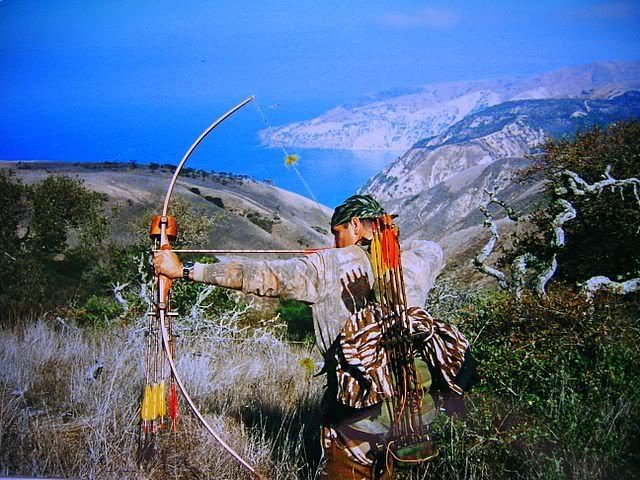
70lb longbow, I shot this one at 3 yards on the ground

Then about an hour later shot this one

right after that one shot another one and it ante even noon yet.
On most Bow hunts you will be lucky to get one shot let alone several.This bow arrow set up was before I ever changed my set up to maximize arrow penetration, I did shoot mostly Zuwickys, because I wanted all the penetration I could get.
One of the reasons I stumbled on the grizzly is I liked the 3-1 ratio, I noticed an immediate increase in penetration completely ignorant of the dynamics of the single bevel.
I am stuck right now with my arrow @ 810 grains with a 28% efoc I can not loud it up any more so my next goal is to get some new shafts and work up a 30%-35% or maybe even a 40% UEFOC arrow.
The fun never stops
-
David Petersen wrote: And hey, I’m no longer even sure what we’re “arguing about” here! :lol::wink: Of course, we aren’t. dave
I don’t look at this as arguing about anything. It’s more like mulling over all the possible variations of a bow set-up. Noting the advantages and disadvantages of each and then intelligently selecting what each thinks will work best in our own situations.
I don’t worry about anyone here going out ill-prepared to do the job and I don’t think I need to be worried about either. My success rate is very high. I love to hear about what other hunters think is important and put a lot of thought into deciding whether it makes good sense to me. I’ve learned a ton from Ed’s studies and look forward to learning even more from all the experience on this forum.
-
My average kill distance (over those last 627 animal, is less than 15 yards (14.97 yards, to be exact). I don’t need pinpoint accuracy at those ranges.
I love your precise statistics! As a whitetail hunter in eastern hardwoods, my average shot distance is much shorter than that – not sure exactly how much :wink:, but my longest shot in 40 years has been 23 yards. However, as an elk hunter, I’ve only had one under 15 yards. They just tend to be in more open areas where you’re not exactly sure where they’ll come through. I definitely put a bigger premium on accuracy when I’m after elk.
-
Thanks Patrick.
The Islands we’re really a special place, you can watch old footage of Howard hill shooting pigs and goats in some of his old moves.
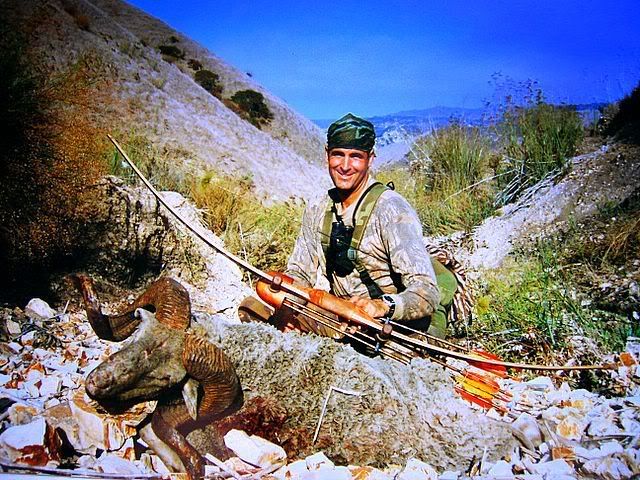
Who would of known that the world would of turned so crazy that they would kill 27,000 head of sheep and let them lie and rot ( the pigs did clean them up as best they could ) then they killed all of the pigs, this was done by the nature conservatory.
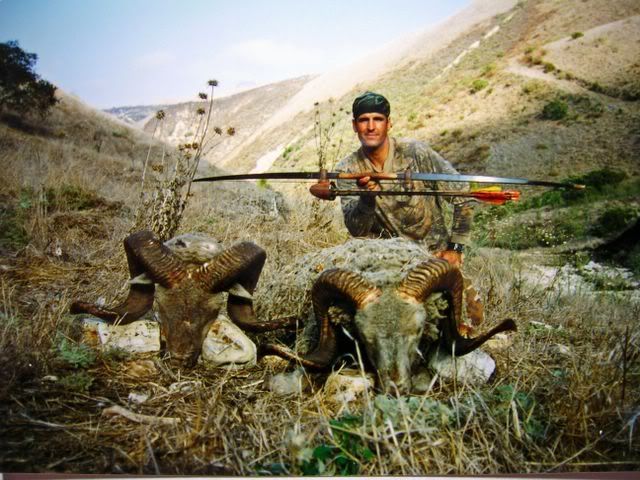
I wish I would of took more picks ( was to busy hunting )

This is a huge chocolate ram, most got killed before they could grow big because every one wanted one.

This is my first trip to Santa Cruz Island, mean lean hunting machine

-
Kingwouldbe wrote:
I understand what your saying Str8arrow, however let’s also not confuse Bowhunting with target archery.Jumping up 15lb will effect most peoples accuracy, it is much better to slowly work up to that weight over the next year
I think I have a pretty good handle on the difference. It’s just that I’d hate to have to limit my shots to 10 yards if I’ve got a bow that allows me to kill at 20 yards.
I use to hunt the Islands off of California, and yes I would sometimes have several shots a day ( wish it was still there ) because you could get ten years of Bowhunting experiences in one, that is so; not the norm.
Wow, what an amazing looking place. If it had an elk population, I just might have to find a way to hunt it.
I am stuck right now with my arrow @ 810 grains with a 28% efoc I can not loud it up any more so my next goal is to get some new shafts and work up a 30%-35% or maybe even a 40% UEFOC arrow.
With those arrows, I’m betting those pigs wouldn’t stand a chance with even a 55 lb draw from with modern limbs. As for a 40% UEFOC arrow, I wish I knew how to build one. I’d love to shoot it.
-
You know whats funny, all I did was tune the arrow to the bow and hunt, I did not even own a grain scale or know what my arrow weight was or anything, I made a lot of mistake along the way.
I did put a sharp edge on all of my broadheads, I could of said why better my equipment as it’s always killed just fine.
The truth is there is the best arrow, then theirs the next best arrow, and so forth…
I am at a place now that I want the best arrow I can possible make, it only increases my effective killing.
-
David, reading the feelings into your words of the hunts now past, thought you’d enjoy this. It’s only those of us who’ve hunted what’s gone that can really appreciate it.
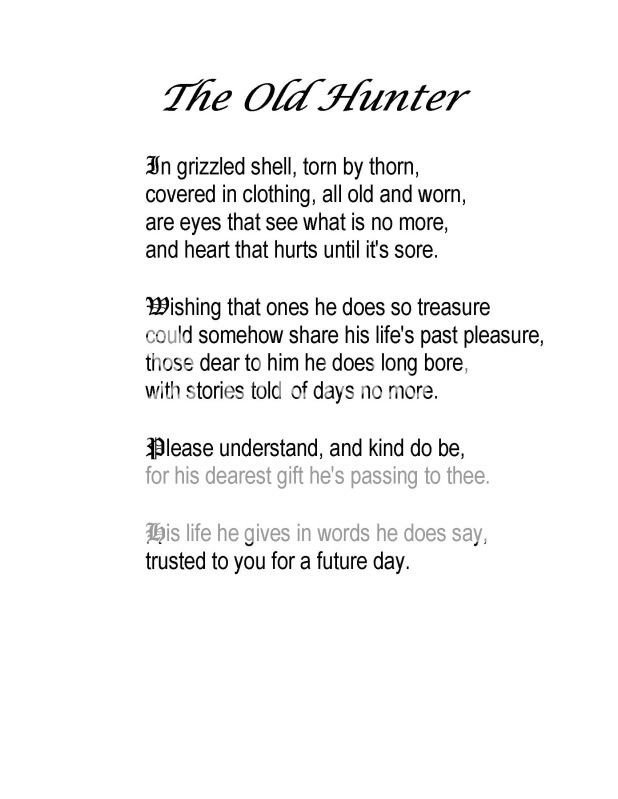
Copyright 1997, Dr. Ed AshbyThanks for sharing, King!
Ed
-
I am really enjoying this thread. I have learned a lot just listening to every one. I wanted to know what kind of sheep were in those beautiful pictures.
Thanks in advance
Tom
-
What’s so Refreashing is that in our sport/way of life, is that we pass on this type of information.
-
Doc. That poem is so true, and it does make my heart hurt, I was able to get my son over there at the vary end, he shot a nice hog as I watched the whole thing across canyon.
Doc. if you don’t mind I would like to post some Island pic’s
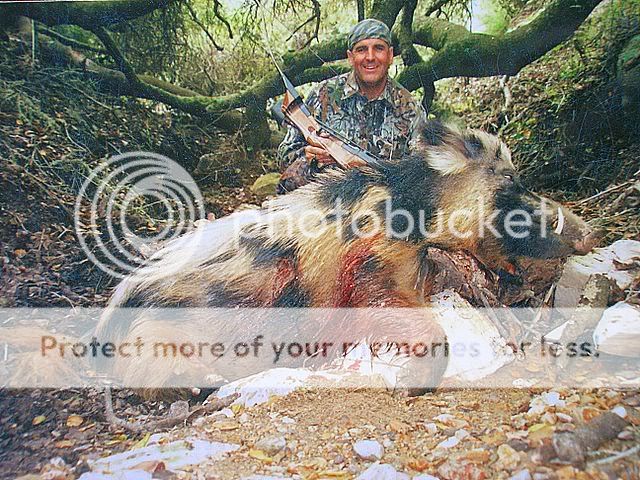
I saw this boar on the edge of some oak trees from about a mile away, I thought it was a pony, first shot was quartering in, he did not want to go down so I had to hit him again, he had a block head with nice cutters,60lb widow.
As I left the hog above I came out of the oak trees to see this guy out feeding.
This is the best shot I have ever made, he was running from my hunting buddy and was coming towards me, I had to run up the ridge to where I thought he would come by, as he came by at full speed I had to swing with him then go way out in front of him to lead him and also pick a window to shot him through, hitting them like Howard comes to mind.
Can you say cutters -
Tom-Wisconsin wrote: I am really enjoying this thread. I have learned a lot just listening to every one. I wanted to know what kind of sheep were in those beautiful pictures.
Thanks in advance
Tom
Tom that is what it’s about.
Well I think there a moreno sheep that the Spaniards dropped off 3 or 4 hundred years ago along with the pigs, they where there along time before the nature conservatory slaughtered them all.
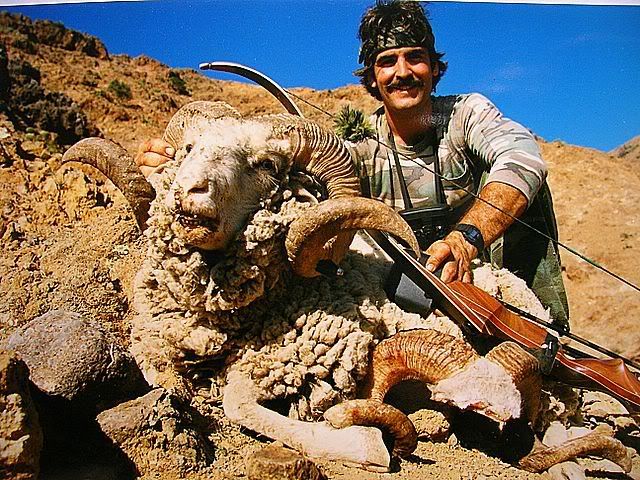
Can you see my broadhead in the horn?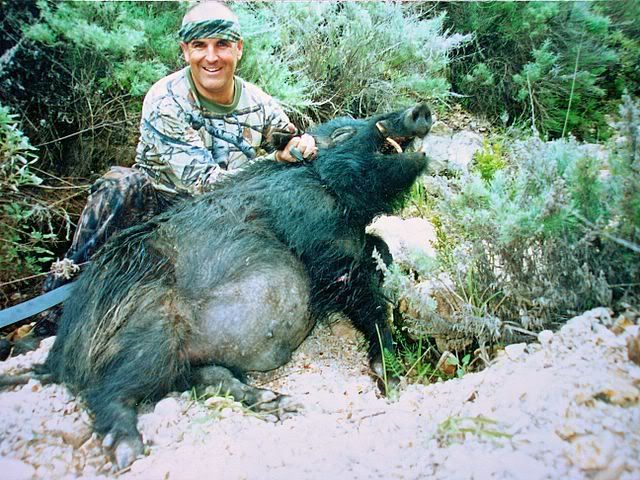
I think I shot this one after he was eating the dead sheep.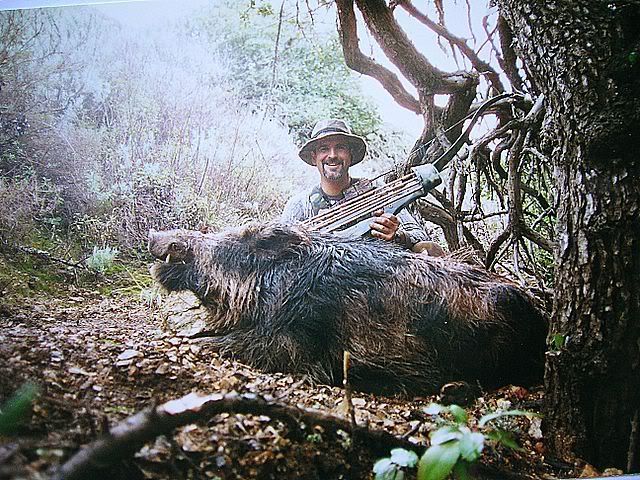
This one we called the shaggy dog.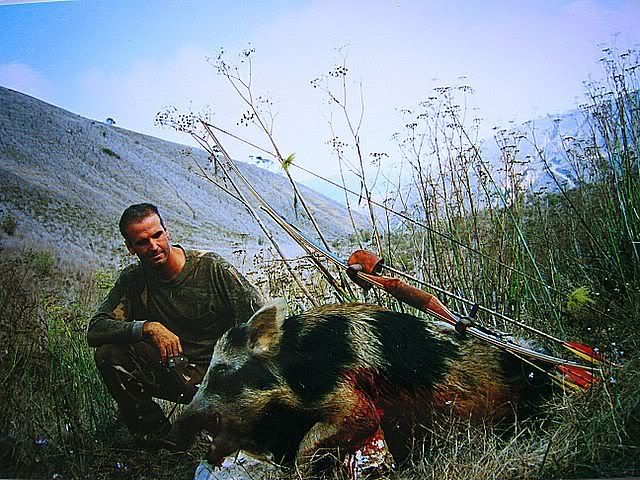
I glassed this boar from the ridge in the back ground, put a big stock on him.
I shot this boar while I was blood trailing another hog.
A true Traditional Bowhunters paradise -
Just watched a show on the discovery channel called “Pig bomb” and how wild boars are spreading every where in the US and in Europe and becomming a real nuisance. Even some where spotted way up here in the Wisconsin North Woods. They say the cause of the increased spread is people planting them in new areas. It seems there behaviors are changing. They once stood and fought to defend their territory but now are running so it is harder to hunt them. They also think the US wild hogs are breeding with imported Russian hogs and so the average weight is increasing and so is the aggressiveness. 😯
-
Dave,
You look so young then.. Simple smile tells it all……
Thanks Bro
-
Mark, I had hair then 😀 the cool thing about the Islands was they where game rich, so you went from stock to stock.

Don’t get me wrong though, you had to work hard.
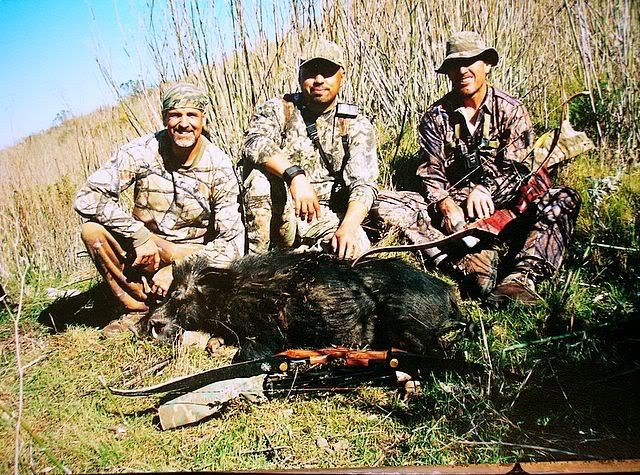
My hunting buddy watched me put the stock on this one
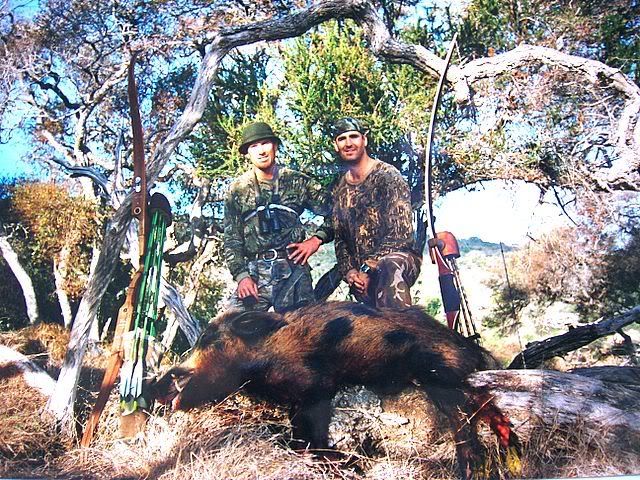
This one was shot at 5 yards in it’s bed.
Sharp delta 2 blade = blood every where.
This is the worst I have ever shot, I missed my first 2 shot over it’s back, it heard the shot but did not know what it was, he was working on a bulb in the grown he would run a little way and come right back to eat the bulb, he never knew I was there until the 3rd shot hit the mark.
-
Dr. Ed Ashby wrote: I know there are no words, David. Daily I grieve the passing of the Africa I knew.
Ed
Ed, I would love to see some pic’s of your time in old Africa, and any where ells for that matter.
-
Sadly I have but few. When The Mugabe government forced me out of Zimbabwe I was given only 24 hours to leave the country. Most of that time was spent at the US Embassy trying to get on a flight on short notice – and be sure I wasen’t detained before I could leave the country (no one had any idea what was occurring at the time, not even the folks at the Embassy). All I got out of Zim with were my rifles (which I was required to remove), my binoculars and one change of clothing. Lost everything; house, car, hunting equipment and gear, data records, and an entire room, stacked floor to cealing, of tanned leather – elephant, hippo, buffalo, zebra, eland, impala, warthog and many, many more – AND almost every photo I had. Also lost hundreds of pounds of horn and a great deal of carved elephant bones, ivory, warthog tusk and many elephant hair bracelets. The living room of my house was a virtual photo gallery, with hundreds of photos tacked to the wall (which all who visited most enjoyed looking at). The few photos I’ve ‘regained’ were ones I had used in articles through the years. Just one more tragedy of Africa’s demise … but at least I have the memories. Those they could not take from me.
I do have a few photos from my youth, and will try to get some of them onto photobucket sometime and post them for you.
Ed
-
Ed, That just made me sick, I know how much my pic’s mean to me 😥
I was vary thank full that early on I would take some pic’s but no where near as many as I should of.
I am sorry for being so off topic, but it’s all about bowhunting
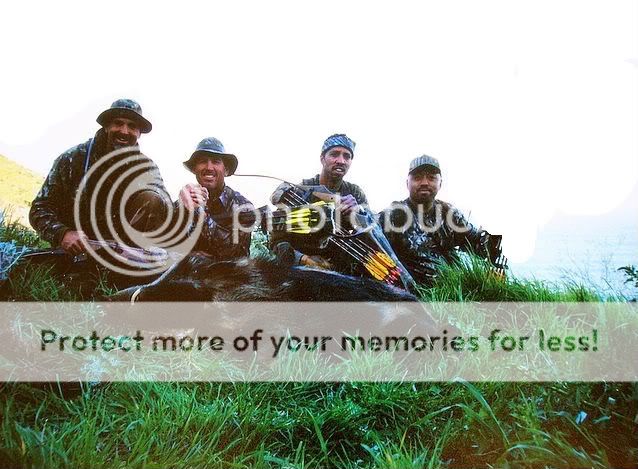
-
Patrick’s right about Mugabe, but that’s only a part of it. When I started hunting Africa it was a sea on animals surrounding small islands of people. Africa in now a sea of people surrounding small islands of animals.
There is very, very little of the wild Africa I knew still left. There’s no places left in Africa in which to replicate those experiences and that way of life. Indescrible.
Ed
-
Ok, a story and then one simple question……….
Have been reading through this and the information posted by Dr Ed, and others is as always some of the best there is, it is and will be information that has and will continue to cause me to look at my gear and the way I hunt and the shots I take.
Now to look down a little different road, and I hope that it is one that is ok to go down…………….
The information that has been gathered by Dr Ed, is and can be a true bonus to the future of responsible bowhunting. I used the word responsible, for a reason, back when I taught bowhunter education, the guy I taught with, good guy, shot a compound, with very light arrows and tiny, tiny heads. I would always say something, but it was a somewhat wasted effort. Deep down he knew, but there were always other things in his schedule, that was more important than practice.
So back on course here. How do we get this back in bowhunting?Tim
-
Tim, it’s my HOPE that this forum will be an epicenter of the information, and that it will radiate from here. The internet is a powerful tool, and there are tons of websites out there devoted to bowhunting. Many have heard of the information, though far fewer have actually read any of it, and even fewer have actually USED the information in their own hunting.
I think a big help, and I’m already seeing the effects, is for those who have actually USED the information in their own hunting and SEEN the results for themselves will be the ‘shock wave’ radiating out from here. David (Kingwouldbe) – and his exceptionally excellent photos – are a great example of someone who is making a big difference. I already KNOW that the information has to be spread by others than me. I have more than a few detractors; those who, for one reason or another wish to discredit and downplay the Study and its information. When multiple other folks keep posting the results they are seeing when they use a better arrow setup, it DOES have an effect on many who read their postings. It’s not going to change the minds that are totally closed, but there are many reading those postings who are open minded too. It’s those folks that must be reached; one by one. Often they are the folks reading the postings, but not adding a post of their own
I was truly impressed with the reception and acceptance the Study information received when I did the presentations at the PBS meeting and ATA show. We are making progress. I’ve been atop this soapbox for over a quarter century – but that has also made me a target for some.
We have come a long, long ways since I started. At the ATA show I was very impresses how many compound shooters have adopted, and are now using information from the Study. I can well understand why the Study’s information isn’t very popular among some manufacturers of bowhunting equipment, but it’s always amazed me that the most vocal and dogmatic of the nay-saying bowhunters appears to be among the ranks of traditional bowhunters.
I will continue doing what I can, but I think that the word spread by others will make inroads far faster than anything I can ever do.
Ed
-
-
AuthorPosts
- You must be logged in to reply to this topic.

